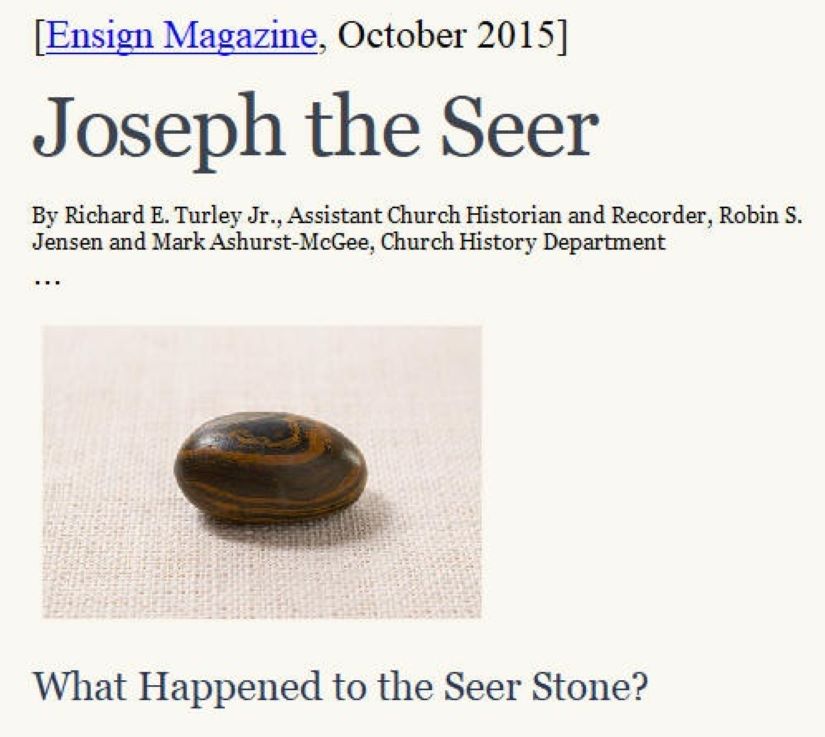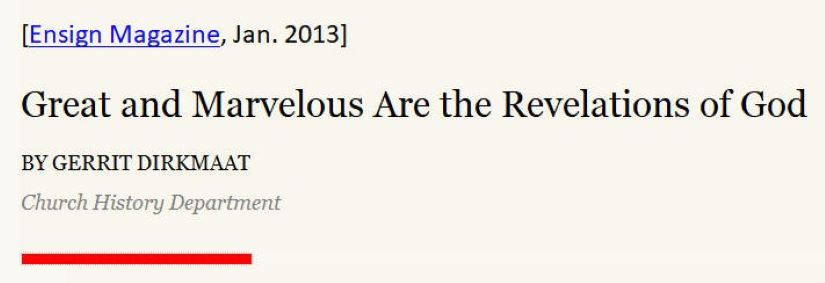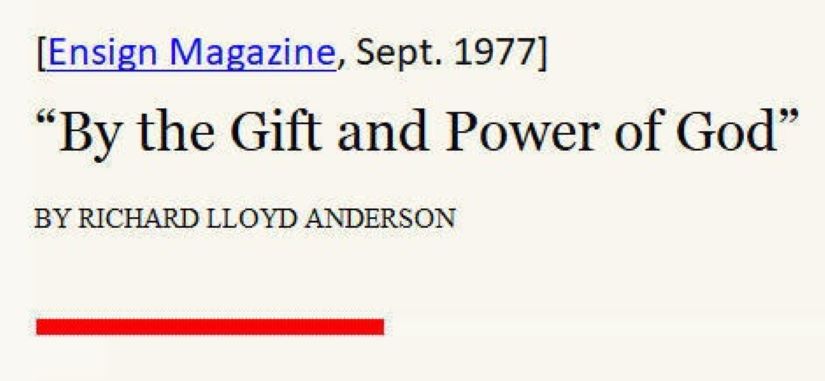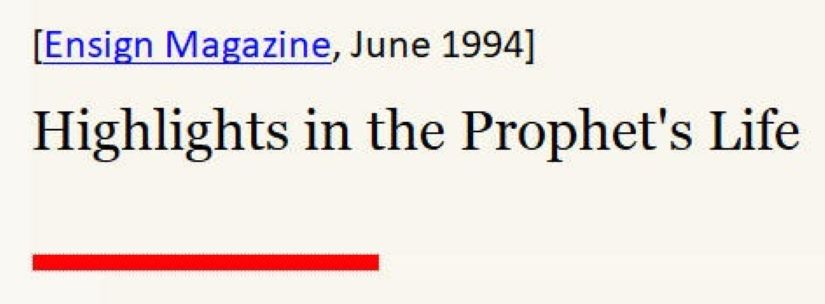
The stone pictured here has long been associated with Joseph Smith and the Book of Mormon translation. The stone Joseph Smith used in the Book of Mormon translation effort was often referred to as a chocolate-colored stone with an oval shape.
According to Joseph Smith’s history, he returned the Urim and Thummim, or Nephite “interpreters,” to the angel. But what became of the other seer stone or stones that Joseph used in translating the Book of Mormon? David Whitmer wrote that “after the translation of the Book of Mormon was finished, early in the spring of 1830, before April 6th, Joseph gave the stone to Oliver Cowdery and told me as well as the rest that he was through with it, and he did not use the stone any more.”

Adapted from an address given 25 June 1992 at a seminar for new mission presidents, Missionary Training Center, Provo, Utah.
A Treasured Testament
…
The details of this miraculous method of translation are still not fully known. Yet we do have a few precious insights. David Whitmer wrote: “Joseph Smith would put the seer stone into a hat, and put his face in the hat, drawing it closely around his face to exclude the light; and in the darkness the spiritual light would shine. A piece of something resembling parchment would appear, and on that appeared the writing. One character at a time would appear, and under it was the interpretation in English. Brother Joseph would read off the English to Oliver Cowdery, who was his principal scribe, and when it was written down and repeated to Brother Joseph to see if it was correct, then it would disappear, and another character with the interpretation would appear. Thus the Book of Mormon was translated by the gift and power of God, and not by any power of man.” (David Whitmer, An Address to All Believers in Christ, Richmond, Mo, 1887, p. 12)

Joseph Smith Received Revelations through the Power of God
Those who believed that Joseph Smith’s revelations contained the voice of the Lord speaking to them also accepted the miraculous ways in which the revelations were received. Some of the Prophet Joseph’s earliest revelations came through the same means by which he translated the Book of Mormon from the gold plates. In the stone box containing the gold plates, Joseph found what Book of Mormon prophets referred to as “interpreters,” or a “stone, which shall shine forth in darkness unto light” (Alma 37:23–24). He described the instrument as “spectacles” and referred to it using an Old Testament term, Urim and Thummim (see Exodus 28:30).
He also sometimes applied the term to other stones he possessed, called “seer stones” because they aided him in receiving revelations as a seer. The Prophet received some early revelations through the use of these seer stones. For example, shortly after Oliver Cowdery came to serve as a scribe for Joseph Smith as he translated the plates, Oliver and Joseph debated the meaning of a biblical passage and sought an answer through revelation. Joseph explained: “A difference of opinion arising between us about the account of John the Apostle … whether he died, or whether he continued; we mutually agreed to settle it by the Urim and Thummim.” In response, Joseph Smith received the revelation now known as section 7 of the Doctrine and Covenants, which informed them that Jesus had told the Apostle John, “Thou shalt tarry until I come in my glory” (D&C 7:3). Records indicate that soon after the founding of the Church in 1830, the Prophet stopped using the seer stones as a regular means of receiving revelations. Instead, he dictated the revelations after inquiring of the Lord without employing an external instrument.

The person who best reflects Martin Harris is probably Edward Stevenson, since he spent nearly two months with the Witness after going to Ohio to escort him back to Utah in 1870. On the means of translation Stevenson reported, “He said that the Prophet possessed a seer stone, by which he was enabled to translate as well as from the Urim and Thummim, and for convenience he then used the seer stone.” After Martin Harris lost the part of the translation done in 1828, Oliver Cowdery became chief scribe for the entire Book of Mormon as it is now printed. Toward the end of this new work of 1829, David Whitmer on occasion watched and afterwards spoke of the seer stone.

A time line of some key events in the life and ministry of Joseph Smith
…
20 Mar. 1826: Tried and acquitted on fanciful charge of being a “disorderly person,” South Bainbridge, Chenango County, New York. New York law defined a disorderly person as, among other things, a vagrant or a seeker of “lost goods.” The Prophet had been accused of both: the first charge was false and was made simply to cause trouble; Joseph’s use of a seer stone to see things that others could not see with the naked eye brought the second charge. Those who brought the charges were apparently concerned that Joseph might bilk his employer, Josiah Stowell, out of some money. Mr. Stowell’s testimony clearly said this was not so and that he trusted Joseph Smith.2
The above Ensign Magazine seer stone quote contains the following endnote reference:
2. Gordon A. Madsen, “Joseph Smith’s 1826 Trial: The Legal Setting,” Brigham Young University Studies, Spring 1990, p. 93.
In Madsen’s work, he said this about Stowell’s testimony:
“The pivotal testimony, in my view, was that of Josiah Stowell. … ‘that he positively knew that the prisoner [Joseph Smith] could tell and professed the art of seeing those valuable treasures through the medium of said stone.'” (Joseph Smith’s 1826 Trial: The Legal Setting, BYU Studies, p. 105)
Articles of interest:
■ Joseph Smith Stone In Hat Routine — Rich Kelsey
■ LDS Urim and Thummim — Rich Kelsey